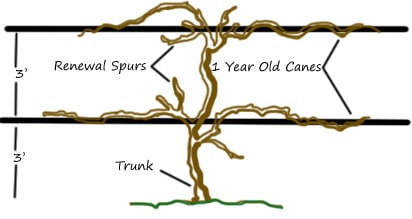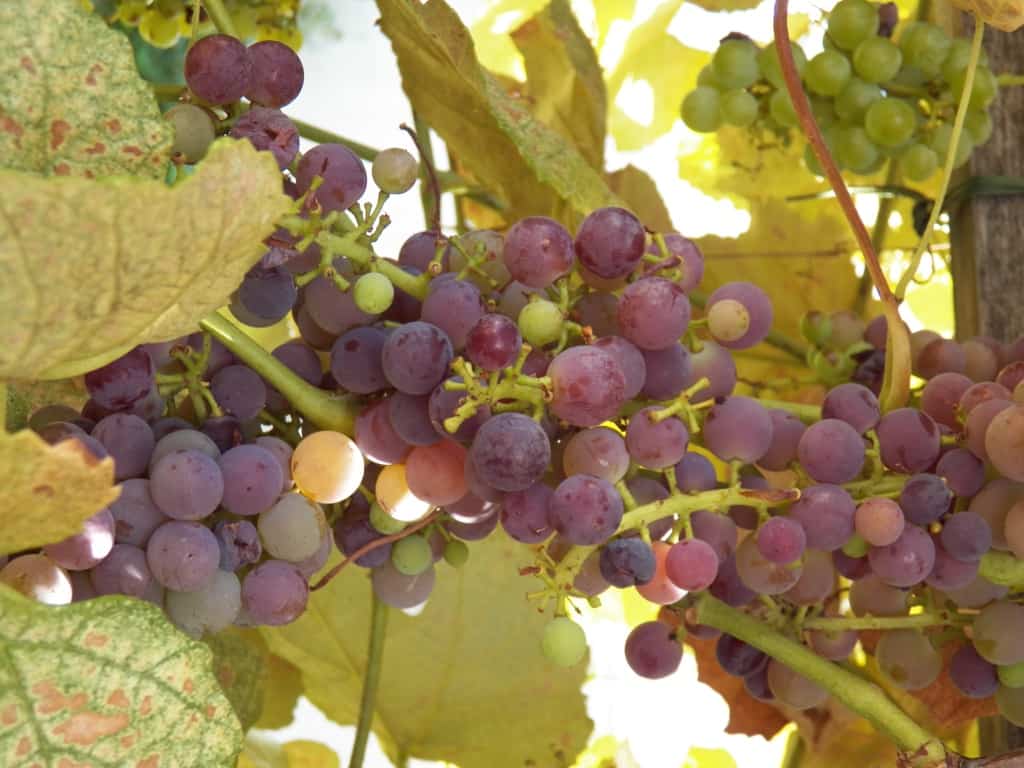I have long been fascinated by the beauty and production of a grapevine. Tendrils clinging to each other, supports, wires, and even trees assure that the vines will reach new heights to find sunlight and air circulation. My grandparents kept the old fashioned but wonderful ‘Concord’ growing on two rows of vines in their garden. Even now I can hear my grandma calling me in the house to try the first batch of grape jam-made with the whole fruit. I have since repeated the jam making process with ‘Concord’ grapes, but not with the success of her years.

During college, I took a course in fruit production and learned firsthand about growing all sorts of fruits, including grapes. I remember little, except for the basis of pruning and training grapes. However, after little reading and remembering, I hope to share information with you on growing grapes in the Great Plains, for fresh eating, jelly, and juice. While there are several wine operations nearby, I have chosen to relay information on growing for homeowner use-not to say you should not try making wine on your own.
Grapes, though they sound difficult with all the information on winemaking out there, are not tough to grow and maintain. A sound foundation for growing grapes starts with selecting a site, preparing the site, and picking the cultivars to grow. The site should be in full sun, away from trees that will compete for nutrients and sunlight. A slope is best, while well-drained soil will work too. Grapes prefer not to have wet feet, hence the slope. A soil test is important to determine the pH balance and soil nutrient requirements before planting. Soil test kits can be purchased from garden centers or you can send soil samples into your state extension university lab.

After you have determined the soil needs of the site, you may want to add organic matter to help improve the soil. For those with space limitations, you can plant grapevines on a trellis by the house, an arbor, or a pergola. For those wanting several varieties of grapes to make jelly or juice, setting up a few long trellises is the best option. There are many designs out there; the best ones will have firmly anchored posts at the ends and from six to ten feet apart, with tight wires from post to post. You can train grapes on one row of wire or two for best producing options. A large wooden trellis system (similar to KSU’s gardens) may have room for up to five rows of vines.

Choosing grapevines for your home production is easier than for strict winemaking. While there are hundreds of named cultivars used in production across the globe, there are only twenty or so that work great in home gardens. You will want to choose varieties for their fresh eating flavor, disease resistance, and cold hardiness to your area. Some seedless varieties include ‘Concord Seedless’, ‘Interlaken’, and ‘Reliance Seedless’. Seeded grapes may be less preferred, but the seeds can be eaten whole or strained out for jelly and juice making. Seeded grapes varieties include ‘Concord’, ‘Steuben’, and ‘Edelweiss’.
Plant the vines in the spring or fall, six to eight feet apart, in rows eight feet apart. Dig a hole roughly 1 ½ times larger than the root ball, and mix in compost as you plant. Water deeply and twice a week for the first two months, until the vines are established. Mulching with sawdust, woodchips, or compost will reduce weeds and prevent soil fluctuations in temperature.
Pruning grapevines sounds like a daunting task, but with regular training and practice, you will have no problems with your vines. The first winters after planting, cut down to one shoot from the base, and tie it up with string. After the second year, select two “arms” from the main shoot and tie those to the wires, cutting them back to two to three buds. If you have two or more wires, you will repeat the arm selection each year until you have vines on each wire. Every spring after the first two years, prune the vines back to three buds on the main shoots.

Grape growing can be fun a profitable for anyone with the time and space to plant them. Consider adding grapes to your garden today!




